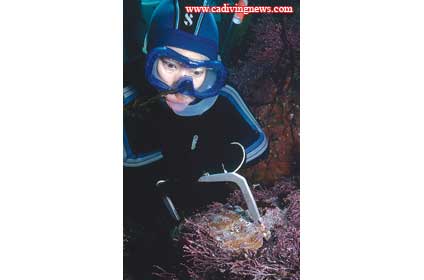Each spring Northern California divers look forward to the beginning of abalone season with the exuberance of children waiting for Santa Claus. With good reason since abalone are one of the tastiest shellfish that you will ever harvest in California and they are still very abundant. Although diving, in general, and abalone diving, specifically, are very safe activities, a small number of abalone divers seem to get hurt each year. The three biggest safety issues in abalone diving are big seas, kelp, and alcohol.
Most injuries occur when divers enter the water when the seas are too big. It makes no sense to drive up the coast only to find that the ocean resembles so many mountains crashing onto the beach, so divers should monitor sea conditions before driving to the beach. NOAA has very accurate marine weather predictions and near real-time buoy information at: http://www.wrh.noaa.gov/mtr/. Another good tool is managed by Scripps Institute of Oceanography at: http://cdip.ucsd.edu/?nav=recent⊂=forecast. Yet another site is managed by Salt Point State Park, although it is often down and tends to be a bit conservative: http://www.saltpointoceanconditions.com/.
Diving should be fantastic when the predicted wind is less than 10 knots, seas are less than 6 feet, and greater than 10 seconds apart. I suggest staying home anytime the winds are over 20 knots and seas over 8 feet. Sometimes it is possible to get in a good dive between these limits, but you may only be able dive from the most protected entries. The direction of the swell and your experience and comfort level also play a factor. Some sites are very well protected from a northwest swell, but are treacherous when the swell switches out of the south. It is a good idea to have dive sites in mind as you watch the weather.
Once on the beach, try observing the ocean for a good 20 minutes or more before committing to the dive. That will give you plenty of time to scope out the biggest wave you are likely to encounter, and the pattern of the wave “sets.” If conditions are marginal and your skills are up to it, try entering and exiting during the smaller sets. Of course, there is no requirement that you enter the water, even after getting up a 4 a.m. and driving for three hours. Remember diving is supposed to be fun, so if conditions are too rough to enjoy the dive–enjoy the beach, have a picnic, go hiking, or visit one of the North Coast’s many quality wineries. There is no good reason to risk getting beat up or injured for a few abalone.
Before you pack up you may want to kelp-proof your gear. While some beginners worry about becoming entangled in kelp, the perception is worse than the actual threat. It is, however, a good idea to minimize the parts of your equipment that can catch kelp stypes. Many abalone divers tape down the loose end of their fin straps with plastic electrical tape. This eliminates the biggest “kelp catcher” on your gear. If you feel you must carry a knife, fasten it on the inside of your leg and not the outside, or better yet, mount it upside down on your upper arm or chest. You will not need a knife to deal with kelp since it breaks very easily by folding it over onto itself. You will, however, need a knife if you are diving around fishing line.
Kelp is very slippery and unless it is very thick, it is easy to swim around and dive through. During the past several years the late season kelp has been very thick and requires a bit of technique. When moving through thick kelp on the surface, do not use your fins, rather user your arms to push down the kelp in front of you and pull it back. With practice, this requires surprisingly little effort and prevents entanglement. Underwater, the kelp is substantially thinner than on the surface, and you should have no trouble navigating among the kelp stypes. Should you become entangled, simply pause and systematically remove the offending pieces, or get your buddy to help. Do not spin around looking for the kelp that is holding you–think of a fork in spaghetti.
The final issue is alcohol. Several years ago, a group of divers drank a six-pack of beer each and split a bottle of whiskey on their way to the beach. It’s not surprising that bad things happened. Alcohol and diving simply do not mix.
Abalone diving can be an exceptionally safe activity if you are aware of your surroundings and plan ahead. If conditions are not right for you, no one if forcing you to dive; it’s your choice.
Remember that you must have in your possession a valid California fishing license along with an abalone punch card, tags, a legal abalone iron and measuring device. Abalone can be taken only by breath-hold diving (no scuba) and only north of San Francisco. The possession and daily bag limit is three abalone. All must be red abalone and be a minimum of seven inches in the largest dimension. The season runs April through June and August through November. Read and understand California Fish and Game regulations before venturing forth.









